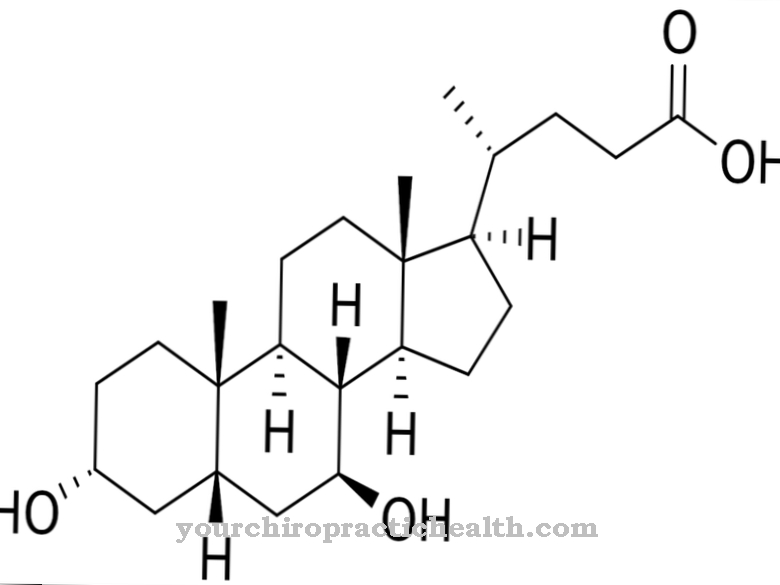Sympathomimetics are active ingredients that stimulate the sympathetic nervous system. The sympathetic nervous system is part of the autonomic nervous system and is involved in various physical functions. Basically, the excitation of this nerve puts the body in a performance-enhancing state. Physiologically, this is the case with stress, for example. Sympathomimetics are used, among other things, to treat colds, asthma and low blood pressure. Some sympathomimetics require a prescription, while other sympathomimetics are available without a prescription. Exercise caution when ingesting it. Even with the non-prescription sympathomimetics contained in nasal sprays, for example, undesirable side effects cannot be ruled out.
What are sympathomimetics?
Sympathomimetics are active ingredients that additionally activate the sympathetic system. The sympathetic is part of the autonomic nervous system. This part of the organism is also called the autonomous nervous system, as it is largely not subject to any arbitrary control. The sympathetic nervous system influences functions that put the human body in an increased state of performance. In pharmacology, a distinction is made between two different classes of sympathomimetics. There are so-called alpha and beta sympathomimetics.
Most drugs based on sympathomimetics require a prescription, as they significantly interfere with different physical functions and can also have risky effects.
Pharmacological effect on the body and organs
The sympathetic nervous system, which is part of the autonomic nervous system, has the task of making the body more willing to perform in times of stress and emergency situations. If the sympathetic nervous system is stimulated by taking sympathomimetics, attention, blood pressure and blood sugar level rise. Furthermore, there is an expansion of the airways and the associated short-term increase in performance. A euphoric state sets in and the appetite is greatly reduced.
With regard to the mechanism of action, a distinction is made between direct and indirect sympathomimetics. The former develop their effect by imitating the messenger substances noradrenaline and adrenaline and thus activate the adrenal receptors. Indirect sympathomimetics lead to an increase in messenger substances in the synaptic cleft of the human brain. The level is kept high on the one hand by an inhibited resumption and on the other hand by an increased distribution. Active ingredients of this type include ephedrine and amphetamine.
Furthermore, these active ingredients are divided into alpha and beta sympathomimetics. Alpha sympathomimetics mainly bind to alpha adrenergic receptors. These active ingredients constrict blood vessels and stabilize blood pressure. Beta-sympathomimetics have an airway-widening effect. In addition to these two classes of substances, there are derivatives that influence both the alpha and beta adrenoreceptors. These alpha and beta sympathomimetics include the active ingredients metaraminol and norephedrine.
Medical application & use for treatment & prevention
When taking alpha sympathomimetics, the smooth muscle cells contract and a so-called vasoconstriction (vascular constriction) occurs. This effect is used in medical applications, for example, to treat inflammation of the nasal mucous membrane. The sympathomimetics cause the mucous membrane to swell and thus alleviate the patient's symptoms. Alpa sympathomimetics are therefore often contained in nasal sprays.
Oral medication of sympathomimetics is also possible. These substances have a blood pressure stabilizing effect and are therefore used when blood pressure fluctuates. The beta sympathomimetics are mainly used in pulmonary medicine. In medicine, substances that act on the so-called beta-2 receptors are mainly used. Fenoterol is one of these substances.
So that these substances only develop their effect locally and not systemically, they are often inhaled in the form of gases. In asthma sufferers, these drugs can provide relief by widening the bronchi, making it easier to breathe. Beta-sympathomimetics are also prescribed for the treatment of chronic obstructive pulmonary disease, or COPD for short.
Other recognized indication areas for sympathomimetics are ADHD, allergies, conjunctivitis, fatigue, obesity, bronchitis and narcolepsy. The latter describes a disturbance in the sleep-wake cycle. Those affected regularly fall asleep.
You can find your medication here
➔ Medicines for colds and nasal congestionRisks & side effects
The spectrum of activity of the sympathomimetics is broad. The risks and side effects depend on the type of sympathomimetic and its dosage. Many drugs that have a stimulating effect on the sympathetic system require a prescription. Some of these substances, such as MDMA, amphetamines or cocaine, are common party drugs and are sold illegally to underage consumers. It is not advisable to consume these drugs without a necessary indication. Side effects such as itching, redness, irritation of the nasal mucous membrane, nausea, nausea, diarrhea, gastrointestinal complaints can occur. Since the dosage of these substances as a party drug is self-directed, possible serious side effects cannot be ruled out. A fatal cardiac arrest can occur, especially in combination with alcohol.
Alpha-sympathomimetics can generally lead to increased irritability. Difficulty concentrating and sleeping can be painful side effects for the patient. Nasal drops containing alpha sympathomimetics should only be taken for a short period of time. In the long term, these damage the nasal mucosa and can lead to dependence. In addition to a general feeling of weakness and increased sweat production, beta-sympathomimetics can lead to cardiac arrhythmias.













.jpg)

.jpg)
.jpg)











.jpg)